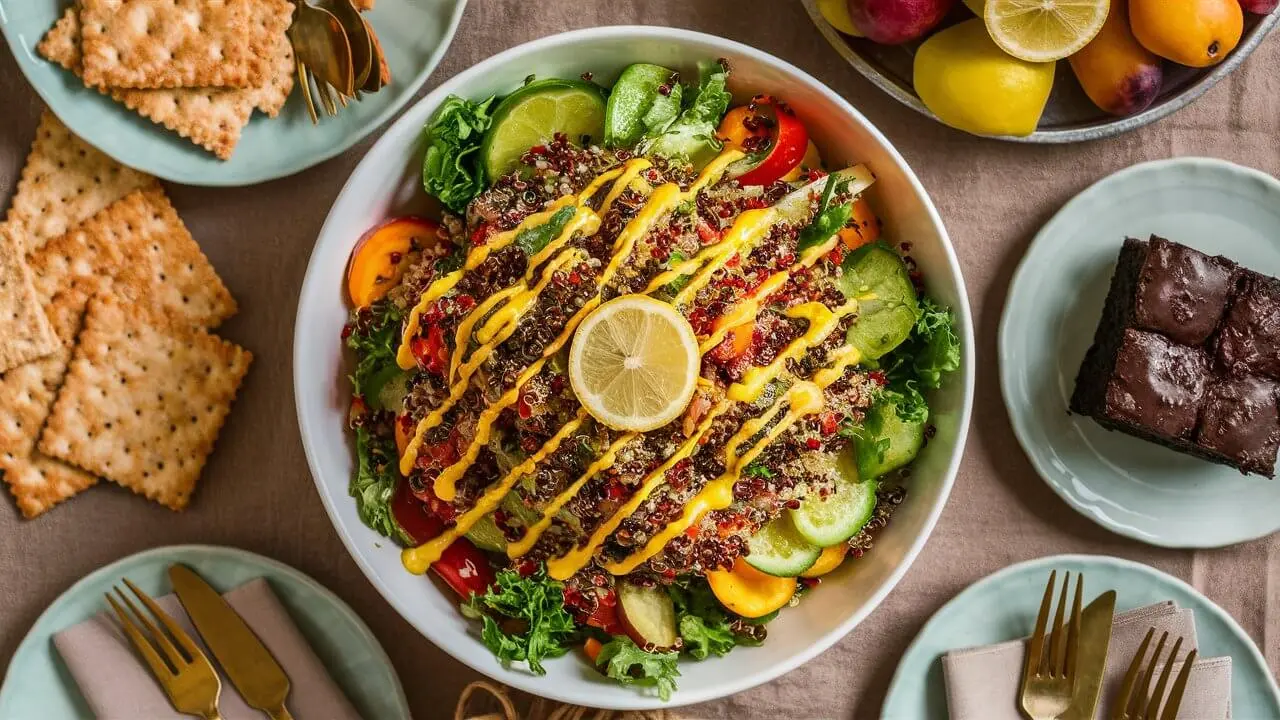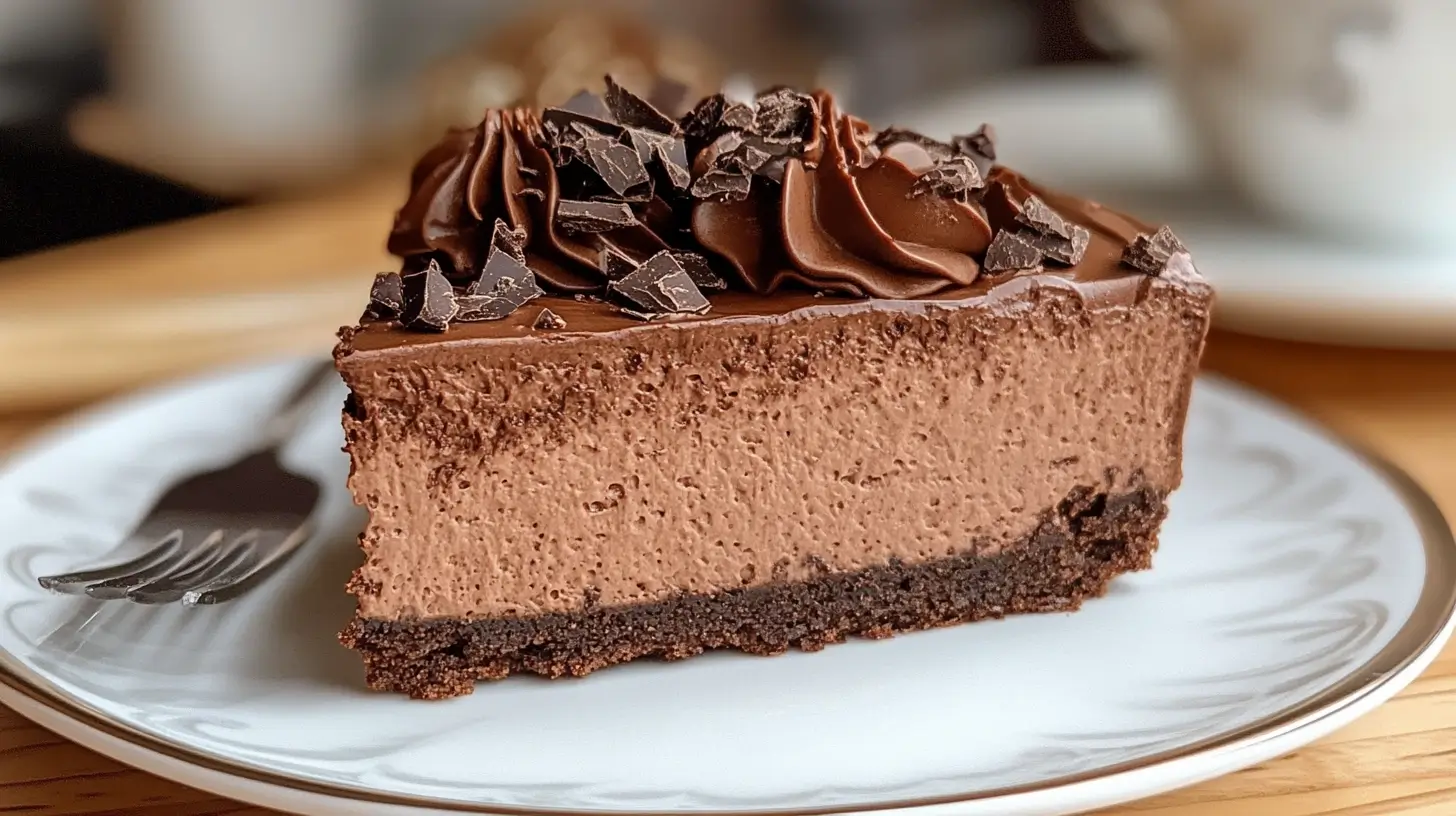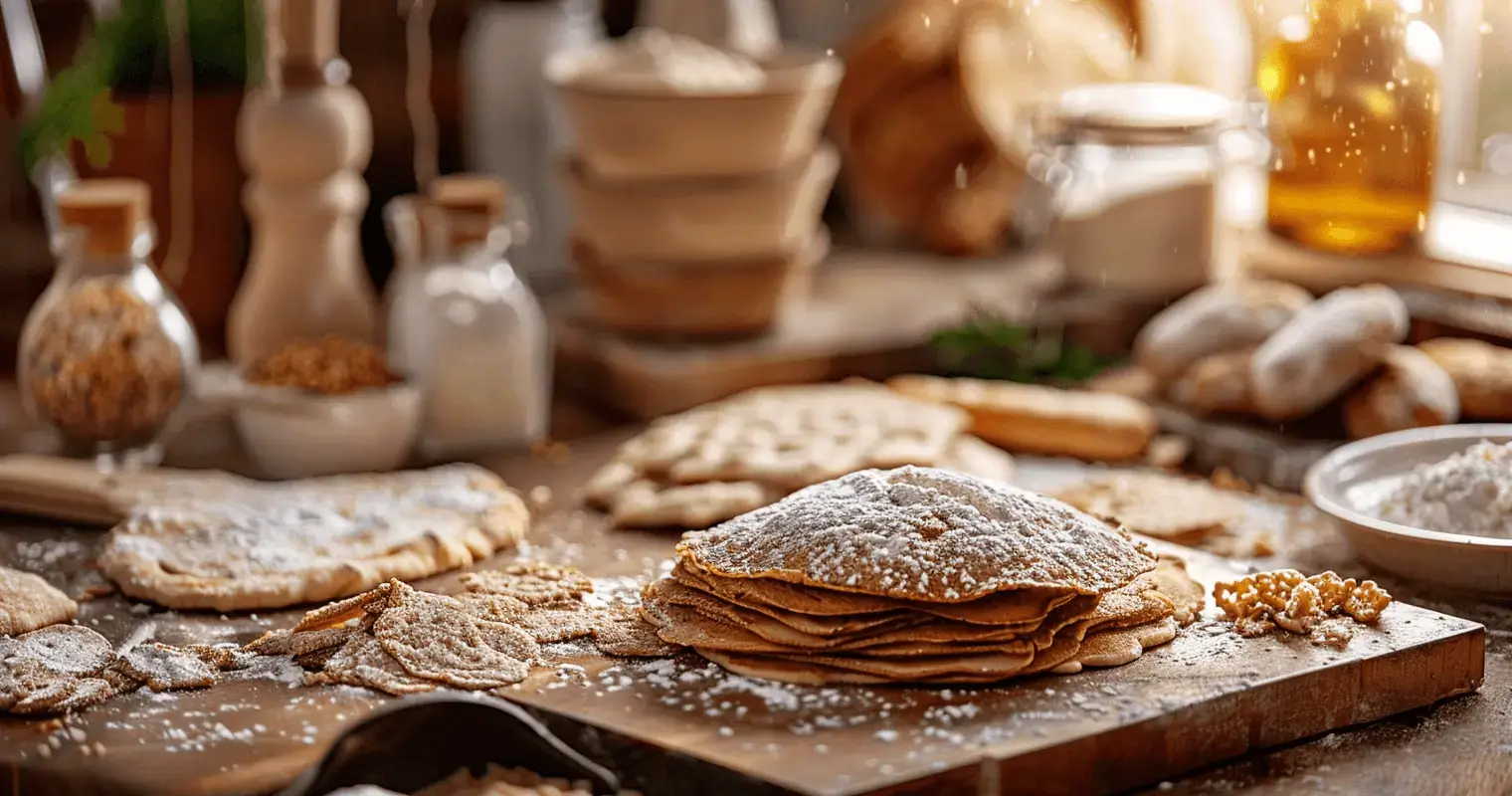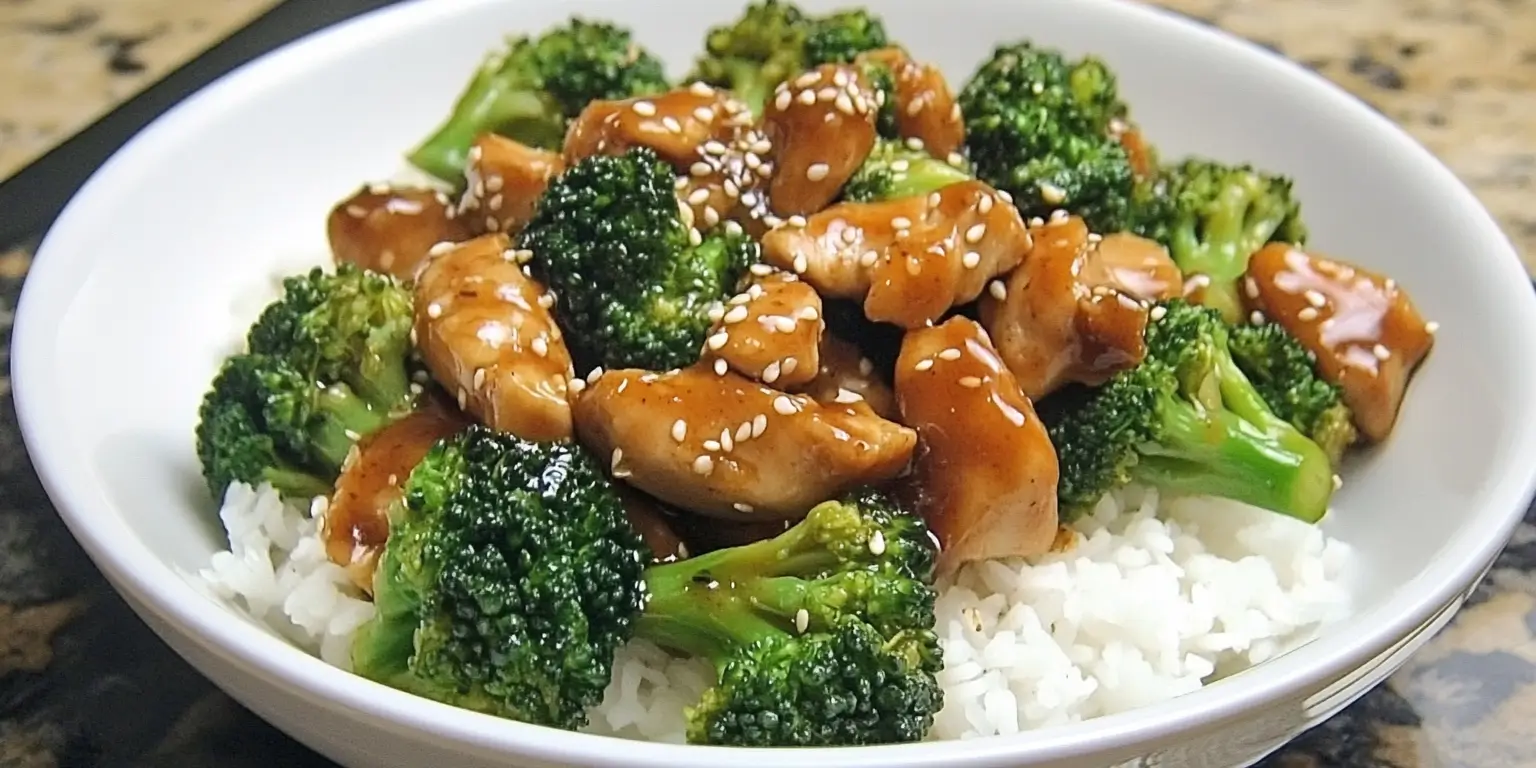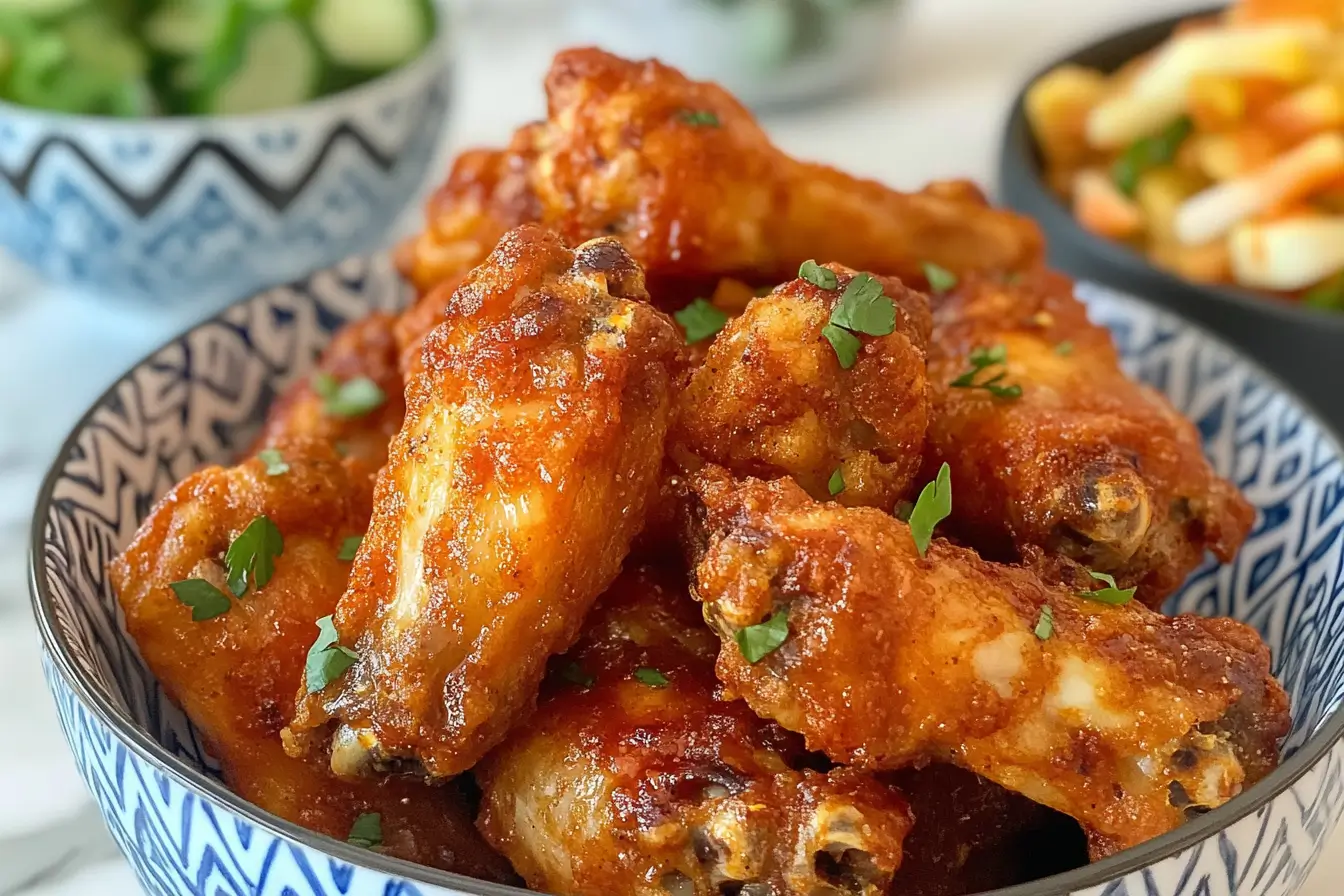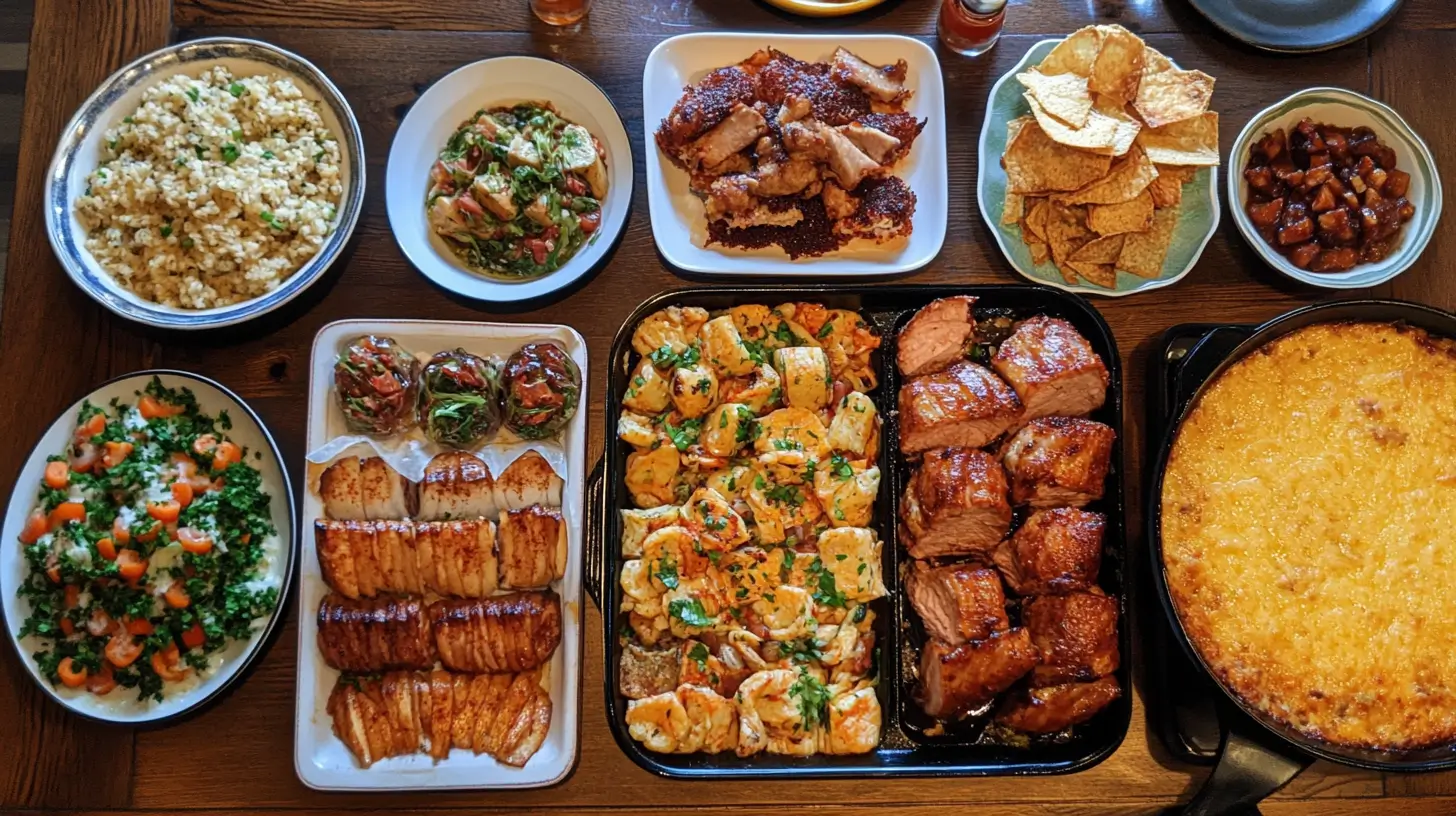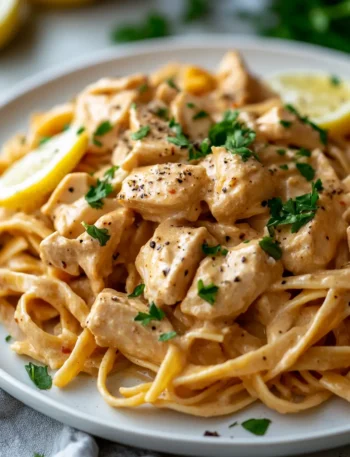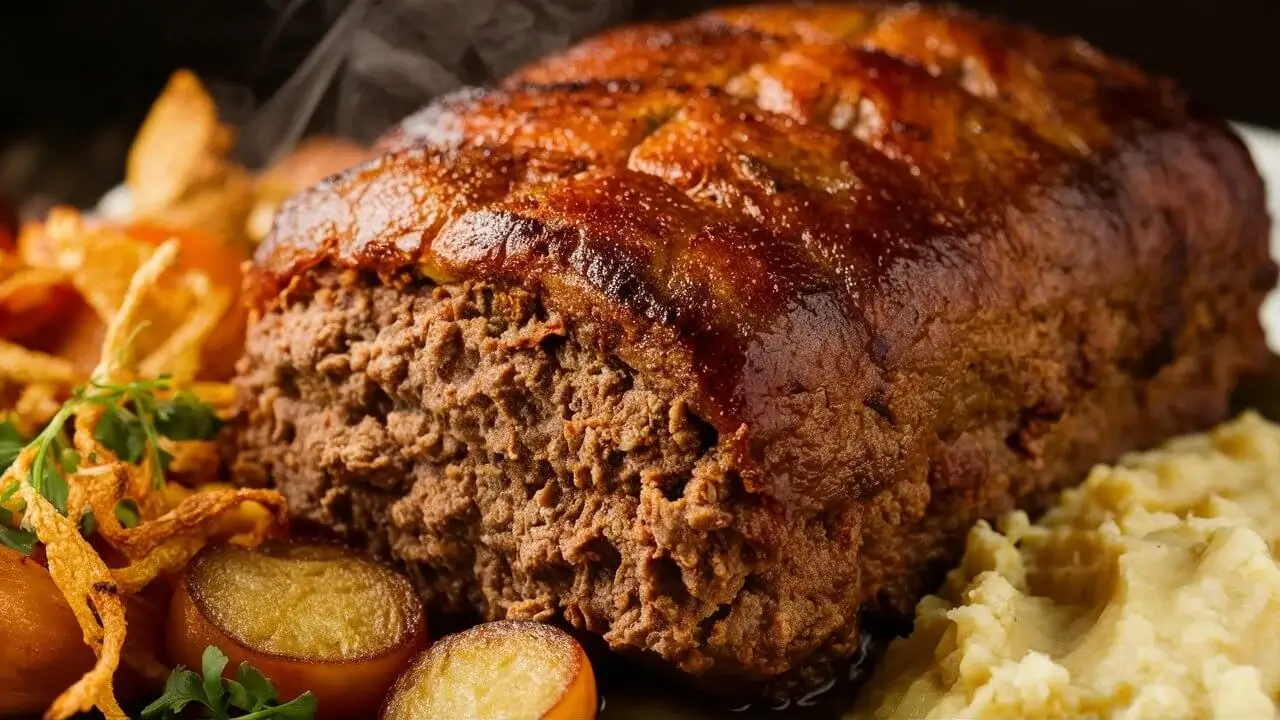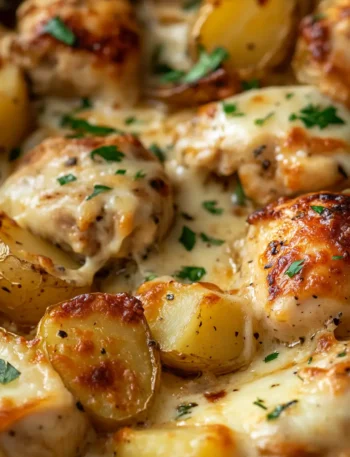The gluten-free diet, “Gluten-Free Lunch Recipes” has gained popularity not just among those with celiac disease or gluten sensitivity but also among health enthusiasts seeking better overall wellness. Cutting out gluten can lead to improved digestion, increased energy levels, and clearer skin. Whether you’re new to the gluten-free lifestyle or a seasoned pro, this article offers a variety of delicious and easy-to-make gluten-free lunch ideas to keep you satisfied and energized throughout your day.
We’ll see the basics of a gluten-free diet, essential kitchen ingredients, and numerous lunch recipes to suit every taste and occasion. From quick and easy options for busy weekdays to creative salads, hearty meals, kid-friendly lunches, and international dishes, you’ll find plenty of inspiration here. Plus, we’ll answer common questions about gluten-free cooking and provide tips to make your meals even more enjoyable.
Understanding Gluten-Free Diets
What Does “Gluten-Free” Mean?
A gluten-free diet excludes any foods containing gluten, a protein found in wheat, barley, rye, and their derivatives. This means avoiding bread, pasta, cereals, and many processed foods that contain gluten as a stabilizer or thickener. For those with celiac disease or non-celiac gluten sensitivity, consuming gluten can lead to severe digestive issues, inflammation, and other health problems.
Health Benefits of a Gluten-Free Diet
Switching to a gluten-free diet can provide numerous health benefits, especially for those with celiac disease or gluten sensitivity. It can alleviate digestive symptoms like bloating, diarrhea, and gas, improve nutrient absorption, and reduce chronic inflammation. Even for those without gluten-related disorders, a gluten-free diet can contribute to better overall health by encouraging the consumption of whole, unprocessed foods.
Essential Ingredients for Gluten-Free Cooking
Staple Gluten-Free Ingredients
To create a variety of tasty gluten-free dishes, stock your pantry with the right ingredients. Here are some staples:
– Gluten-Free Grains: Rice, quinoa, buckwheat, millet, and corn.
– Flours: Almond flour, coconut flour, rice flour, and tapioca flour.
– Starches: Potato starch, arrowroot, and cornstarch.
– Legumes: Lentils, chickpeas, and black beans.
– Nuts and Seeds: Almonds, sunflower seeds, chia seeds, and flaxseeds.
– Dairy Alternatives: Almond milk, coconut milk, and soy milk.
– Fresh Produce: Fruits, vegetables, and herbs.
Avoiding Cross-Contamination
Cross-contamination is a major concern when preparing gluten-free meals. Simple tips so your kitchen be safe:
– Separate Cooking Tools: Use dedicated gluten-free utensils, cutting boards, and cookware.
– Clean Surfaces: Thoroughly clean all surfaces and equipment before preparing gluten-free foods.
– Label Ingredients: Clearly label gluten-free ingredients and store them separately from gluten-containing items.
– Be Cautious with Packaged Foods: Always read labels to guarantee products are truly gluten-free.
Quick and Easy Gluten-Free Lunch Ideas
Simple Recipes for Busy Weekdays
When you’re short on time, these quick and easy gluten-free lunch ideas will come in handy:
Creamy Egg Salad
– Ingredients: Hard-boiled eggs, mayonnaise, Dijon mustard, celery, salt, and pepper.
– Instructions: Chop the eggs and mix with the remaining ingredients. Serve on gluten-free bread or lettuce wraps.
Herbed Tuna and White Bean Salad
– Ingredients: Canned tuna, white beans, cherry tomatoes, red onion, parsley, olive oil, lemon juice, salt, and pepper.
– Instructions: Combine all ingredients in a bowl and toss gently. Serve chilled or at room temperature.
Importance of Meal Preparation
Preparing meals ahead of time can save you a lot of hassle during the week. Spend a few hours on the weekend prepping ingredients and assembling lunches to grab and go. This verify you have nutritious options readily available and helps you stick to your gluten-free diet without feeling overwhelmed.
Creative Salads That Satisfy
Innovative Gluten-Free Salad Recipes
Salads don’t have to be boring. Here are some creative gluten-free salad ideas that are both satisfying and delicious:
Shrimp Avocado Salad
– Ingredients: Cooked shrimp, avocado, cherry tomatoes, cucumber, red onion, lime juice, cilantro, salt, and pepper.
– Instructions: Mix all ingredients in a large bowl and serve chilled.
Chicken Poppy Seed Salad
– Ingredients: Grilled chicken breast, mixed greens, strawberries, almonds, poppy seed dressing, salt, and pepper.
– Instructions: Slice the chicken and combine with the remaining ingredients. Toss with the dressing just before serving.
Tips for Dressing and Adding Crunch Without Gluten
– Dressings: Make your own dressings using olive oil, vinegar, citrus juice, and fresh herbs to confirm they are gluten-free.
– Crunch: Add texture with gluten-free croutons, nuts, seeds, or crispy chickpeas.
Hearty Meals for a Satisfying Lunch
Filling Gluten-Free Recipes Perfect for Lunch
For a more substantial lunch, try these hearty gluten-free recipes:
Bean & Beef Slow-Cooked Chili
– Ingredients: Ground beef, kidney beans, black beans, diced tomatoes, bell peppers, onion, garlic, chili powder, cumin, salt, and pepper.
– Instructions: Brown the beef and sauté the vegetables, then combine all ingredients in a slow cooker. Cook on low for 6-8 hours.
Grilled Flank Steak with Summer Relish
– Ingredients: Flank steak, olive oil, garlic, salt, pepper, cherry tomatoes, corn, red onion, basil, and balsamic vinegar.
– Instructions: Marinate the steak, grill to desired doneness, and top with the summer relish made from the remaining ingredients.
How to Make These Meals Ahead of Time
Prepare these hearty dishes in larger batches and store them in individual portions for an easy grab-and-go lunch option. Reheat as needed for a quick, satisfying meal.
Gluten-Free Lunches for Kids
Kid-Friendly Gluten-Free Lunch Ideas
Make lunchtime fun and appealing for kids with these gluten-free options:
Quinoa & Black Bean Stuffed Peppers
– Ingredients: Bell peppers, cooked quinoa, black beans, corn, cheese, salsa, and spices.
– Instructions: Mix the filling ingredients, stuff the peppers, and bake until tender.
Turkey and Apple Arugula Salad
– Ingredients: Sliced turkey, apple slices, arugula, walnuts, dried cranberries, and honey mustard dressing.
– Instructions: Combine all ingredients and toss with the dressing just before serving.
Tips for Making Lunches Fun and Appealing to Children
– Presentation: Use colorful containers and fun shapes to make meals visually appealing.
– Involvement: Let kids help with meal preparation to increase their interest in eating healthy, gluten-free foods.- Variety: Offer a mix of textures and flavors to keep lunches exciting.
International Gluten-Free Dishes
Gluten-Free Lunch Ideas from Around the World
Expand your culinary horizons with these international gluten-free lunch ideas:
Mediterranean Turkey Skillet
– Ingredients: Ground turkey, spinach, cherry tomatoes, olives, feta cheese, garlic, oregano, and olive oil.
– Instructions: Sauté the turkey with garlic and spices, then add the vegetables and cook until tender. Top with feta cheese before serving.
Feta Shrimp Skillet
– Ingredients: Shrimp, feta cheese, cherry tomatoes, garlic, spinach, lemon juice, and olive oil.
– Instructions: Sauté the shrimp with garlic, then add the remaining ingredients and cook until heated through.
Adapting International Dishes to Be Gluten-Free
Many traditional dishes from around the world can be easily adapted to be gluten-free. Focus on using fresh, whole ingredients and avoid pre-packaged sauces or seasonings that might contain gluten.
Enriching Your Gluten-Free Cooking Skills
Embracing a gluten-free lifestyle opens up a world of culinary creativity. One of the keys to successful gluten-free cooking is mastering the art of combining flavors and textures. Fresh herbs like basil, cilantro, and parsley can add a burst of flavor to salads and main dishes. Spices such as cumin, paprika, and turmeric not only enrich the taste but also offer additional health benefits. By diversifying your flavor profile, you can make each meal exciting and delicious.
Delve Into Gluten-Free Baking
Gluten-free baking can be a rewarding adventure. Start with simple recipes like gluten-free muffins, cookies, and quick breads to build your confidence. Investing in quality gluten-free flour blends can make a significant difference in your baking results. These blends are often formulated to mimic the properties of wheat flour, providing better texture and structure to your baked goods. Additionally, using binders like xanthan gum or psyllium husk can help improve the elasticity and crumb of gluten-free bread and pastries. Try different recipes and ingredients to find what works best for you.
Adapting Family Favorites
Transitioning to a gluten-free diet doesn’t mean giving up your favorite family recipes. Many traditional dishes can be easily adapted to be gluten-free with a few simple substitutions. Swap out regular pasta for gluten-free varieties, use gluten-free breadcrumbs in meatballs and casseroles, and choose gluten-free soy sauce for stir-fries. With these adjustments, you can continue to enjoy the comforting flavors of your cherished meals without compromising on taste or texture. Sharing these adapted recipes with family and friends can also help them appreciate the deliciousness of gluten-free cooking.
Staying Inspired with New Recipes
Keeping your meals varied and interesting is crucial to maintaining a gluten-free diet long-term. Subscribe to gluten-free cooking blogs, join social media groups, and see gluten-free cookbooks for new recipe ideas. Engaging with a community of gluten-free cooks can provide support, inspiration, and practical tips. Trying new recipes not only keeps your taste buds excited but also verify you are getting a wide range of nutrients. From international cuisines to seasonal specialties, there’s an endless array of gluten-free dishes to discover and enjoy.
Adapting International Dishes to Be Gluten-Free
Many traditional dishes from around the world can be easily adapted to be gluten-free. Focus on using fresh, whole ingredients and avoid pre-packaged sauces or seasonings that might contain gluten. Some herbs and spices bring authentic flavors to your gluten-free meals.
Enrishing Your Gluten-Free Cooking Skills
Embracing a gluten-free lifestyle opens up a world of culinary creativity. One of the keys to successful gluten-free cooking is mastering the art of combining flavors and textures. Fresh herbs like basil, cilantro, and parsley can add a burst of flavor to salads and main dishes. Spices such as cumin, paprika, and turmeric not only enrich the taste but also offer additional health benefits. By diversifying your flavor profile, you can make each meal exciting and delicious.
Look Into Gluten-Free Baking
Gluten-free baking can be a rewarding adventure. Start with simple recipes like gluten-free muffins, cookies, and quick breads to build your confidence. Investing in quality gluten-free flour blends can make a significant difference in your baking results. These blends are often formulated to mimic the properties of wheat flour, providing better texture and structure to your baked goods. Additionally, using binders like xanthan gum or psyllium husk can help improve the elasticity and crumb of gluten-free bread and pastries.
Adapting Family Favorites
Transitioning to a gluten-free diet doesn’t mean giving up your favorite family recipes. Many traditional dishes can be easily adapted to be gluten-free with a few simple substitutions. Swap out regular pasta for gluten-free varieties, use gluten-free breadcrumbs in meatballs and casseroles, and choose gluten-free soy sauce for stir-fries. With these adjustments, you can continue to enjoy the comforting flavors of your cherished meals without compromising on taste or texture. Sharing these adapted recipes with family and friends can also help them appreciate the deliciousness of gluten-free cooking.
Staying Inspired with New Recipes
Keeping your meals varied and interesting is crucial to maintaining a gluten-free diet long-term. Subscribe to gluten-free cooking blogs, join social media groups, and see gluten-free cookbooks for new recipe ideas. Engaging with a community of gluten-free cooks can provide support, inspiration, and practical tips. Trying new recipes not only keeps your taste buds excited but also make sure you are getting a wide range of nutrients. From international cuisines to seasonal specialties, there’s an endless array of gluten-free dishes to discover and enjoy.
Conclusion
Embracing a gluten-free lifestyle doesn’t mean you have to give up on delicious, satisfying lunches. With a variety of recipes, meal planning tips, and creative ideas, you can enjoy a wide range of flavorful and nutritious gluten-free meals. Whether you’re cooking for yourself, your family, or preparing meals for busy weekdays, the possibilities are endless. Dive into these gluten-free lunch ideas and discover how enjoyable and diverse a gluten-free diet can be.
FAQs
What are some gluten-free alternatives for bread?
There are many delicious gluten-free bread alternatives available, including those made from rice flour, almond flour, and coconut flour. Additionally, you can use lettuce wraps, rice cakes, or gluten-free tortillas as substitutes.
How do I guarantee a meal is truly gluten-free?
To make sure a meal is truly gluten-free, read labels carefully, use dedicated gluten-free utensils and cookware, and avoid cross-contamination by keeping gluten-free ingredients separate from those containing gluten.
Can gluten-free diets help with weight loss?
While a gluten-free diet is not specifically designed for weight loss, it can lead to healthier eating habits by encouraging the consumption of whole, unprocessed foods. This, in turn, can help with weight management.
Are gluten-free products more expensive?
Gluten-free products can be more expensive than their gluten-containing counterparts due to the specialized ingredients and manufacturing processes. However, making meals from scratch using naturally gluten-free ingredients can be cost-effective.
What are the health benefits of a gluten-free diet?
The health benefits of a gluten-free diet include improved digestion, increased energy levels, and reduced inflammation, particularly for those with celiac disease or gluten sensitivity.
Additional Tips for Gluten-Free Meal Planning
Batch Cooking and Freezing
Batch cooking is a lifesaver for busy individuals. Prepare larger quantities of gluten-free dishes and freeze individual portions. This method guarantees you always have a healthy meal on hand, reducing the temptation to reach for gluten-containing convenience foods.
Incorporating Seasonal Produce
Using seasonal fruits and vegetables not only adds to the flavor of your meals but also guarantees you get the freshest and most nutritious ingredients. Visit local farmers’ markets to find what’s in season and incorporate these into your gluten-free lunch recipes.
Experimenting with Gluten-Free Grains
Expand your grain repertoire by experimenting with various gluten-free grains like teff, amaranth, and sorghum. Each grain offers unique flavors and textures, adding variety to your meals and ensuring you don’t get bored with your diet.
Resources and Further Reading
For more information and to further expand your gluten-free knowledge, here are some valuable resources:
Comprehensive Guide to Gluten-Free Foods – This guide from the Celiac Disease Foundation provides an extensive list of gluten-free foods and tips for maintaining a gluten-free diet.
Expert Insights on Gluten-Free Diets – The Mayo Clinic offers detailed information on the benefits and challenges of a gluten-free diet.
Look into Gluten-Free Product Options at Whole Foods – Whole Foods Market showcases a variety of gluten-free products available for purchase.

